We acknowledge the Wurundjeri people as the early inhabitants of this area.

Subdivision of part of Crown Portion 62 and 63 by private developers commenced after the gold rush. (From Barrett, The Inner Suburbs)
Collingwood land was first auctioned by the Crown in Sydney in 1838-1839, in large allotments of around 25 acres. The area bounded by Simpson’s Road (Victoria Street) Church Street and the Yarra was sold as Portions 60, 61, 62 and 63. Our walk today covers Portions 62 and 63 and part of 61.
Introduction: rus in urbe or Manchester of the Southern Hemisphere?
This part of Abbotsford, bounded by the Yarra River and backgrounded by the tree-covered rise of Studley Park, provides an historical representation of the conflict between the desire to enjoy the idyllic residential possibilities of what was, in the 1840s and 1850s, a semi-rural area, and the industrial entrepreneurship of northern hemisphere migrants who were determined to make a success in this new land. Opportunities expanded after the increasing population following the gold rush enlarged the market for meat, leather goods, bricks and many other commodities. For these industries water was essential both for processing purposes, and for carrying away waste products. It had become apparent as early as 1855 that the Yarra was being polluted, but the Yarra Pollution Prevention Bill to minimise further damage was bitterly contested, and the ensuing Act was often observed more in word than deed. Most notable industrialists in the area stood for council, or paid large rates on their extensive properties; many were Justices of the Peace and prominent in the local community.
When brickmaker Robert Dehnert stood for council in the 1870s, his stated goal was to see ‘as many factories on the Yarra as possible; this would be the only way to make Collingwood a second Manchester, as the district was naturally formed for industrial establishments.’ Nor did these industrialists see any conflict between work and home; most of them lived right next to their works, whether wool-washing, brewing, tanning, brickmaking or candle and soap manufacture. Mainly migrants from Northern England and from Germany, they were practical and hardworking men. However, as the large estates of early settlers were gradually subdivided for building allotments, estate agents still sang the praises of an area that lay within walking distance of city offices, while offering a tranquil natural environment for the leisure hours of the working man. In the mid-1860s these issues were again debated in Parliament and William Vale observed:
The real question was, whether the banks of the Yarra should be conserved for the residences of a few wealthy men, or whether they should afford the means of employment for the large population that had settled at Collingwood and Richmond. It was a battle between the possessors of 500 villa residences and a population of 15,000 or 20,000.
This area has seen an enormous amount of change since 1840, and the traces of its history take some seeking out. Now the twenty-first century is seeing an accelerated spurt of development as high rise buildings reach for the sky. No longer is the conflict between industry and residential amenity, but with a certain model of residence which may threaten the broader access to riverside amenity.
Start at the Walmer St Bridge.
This bridge, although it also provides pedestrian access between Abbotsford and Studley Park, was primarily constructed to transport fresh water from a reservoir on the Studley Park Hill to the Botanical Gardens. Unfortunately just after completion the record-breaking flood of July 1891 destroyed the bridge, and it had to be re-built. For more information about this water supply, see the 2010 Walk on this website and read the Notes on the Pumping Station.
Walk below the footbridge and head west along the riverbank. You will be at the back of Site 1.
1. Graham’s Brewery, Shamrock Brewery, Nycander Vinegar Company, MFB Training College. By 1862 Thomas Graham was living in Victoria Street in a substantial brick house known as Ferry Lodge, next door to a disused brewery owned by brickmaker James Brown. Graham had formerly owned or managed hotels in various parts of Victoria and embraced the opportunity to purchase the old brewery in September 1864. He died in 1871, leaving a substantial estate (leading to a series of court cases owing to his untidy private life, littered with bigamous wives and a range of offspring). His funeral was reported in The Herald 3 Feb 1871: The funeral cortege was fully a mile in length. At the Manchester Unity Hall… it was joined by a large number of members of the Manchester Unity Independent Order of Oddfellows, of which Mr Graham was a Past Grand Master. The brewery was eventually bought by Messrs Boyd and Head of the Crown Brewery in Fitzroy, enlarged and expanded, and renamed the Shamrock Brewery, which was one of the firms which amalgamated in 1907 to form Carlton and United Breweries. It was re-built as an imposing tall brick structure around 1890, and was later used by Nycander Vinegar Company. The famous skipping girl illuminated sign was erected on top of it in 1936. After the factory was demolished ca. 1968, the Melbourne Fire Brigade Training College occupied this site until demolished in turn to make way for a new development.

Thomas Graham’s Simpson’s Road Brewery between 1865 and 1871. The roof and chimney to the right probably indicate his residence “Ferry House”. We guess that the stout fellow with the top hat is Mr Graham. From the State Library of Victoria
To read more about the Shamrock Brewery and see a photo of the later building, click here.
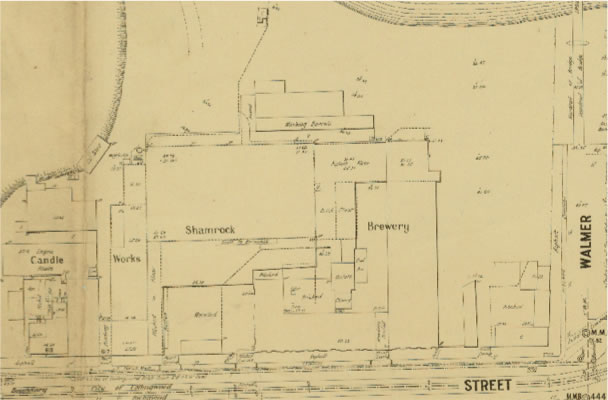
MMBW Detail Plan No. 1304 showing the Shamrock Brewery (and neighbouring candle works owned by Henry Walker). Henry Boyd lived in Graham’s house for some years, but by this date (around 1901) the house is no longer in existence.
Follow the track by the river until you reach site 2.
2. Flockhart Reserve. A small park rezoned as a public recreation reserve in 2003 and named after the street, which was named after tanner Robert Flockhart. Originally called Brick Lane, this street was virtually never residential except for a couple of houses near Victoria Street. It was occupied by a tannery, clay pits, brick works and market gardens. The 1858 map shows clay pits on both sides. Brickmaker Joseph Shirley built the Brickmaker’s Arms in Victoria St in 1853, providing accommodation for his employees. In the mid-nineteenth century, brickmaking was mainly a small scale and sometimes seasonal business. As the century progressed larger brickmakers began to dominate and buy out smaller concerns. One Abbotsford brickmaker who went on to bigger and better things was Augustus Fritsch of Victoria Street who moved operations from Abbotsford to Hawthorn and expanded his business in partnership with his relation by marriage, Holzer. Other brickmakers found alternative occupations or retired.
Brickmaker Robert Dehnert, one of the many German immigrants in this area, bought the Brickmaker’s Arms then rebuilt it on its current corner site around 1867. Dehnert stayed on, making his living from hotelkeeping and tip fees. As the clay pits were worked out, the holes in the ground seemed ideal as rubbish repositories. From the late 1880s complaints began to be heard about malodourous rubbish, sometimes at Collingwood council’s tip, but especially from the private tip on land owned by Dehnert. In 1889 Dehnert was prosecuted for the offences relating to his tip near the banks of the river, which turned into a putrid lagoon when the river overflowed its banks. No fewer than 32 pigs were counted rooting in the rubbish. In 1893 he was again prosecuted for permitting pigs to feed upon blood and decayed matter in his tip and fined 3 pounds.
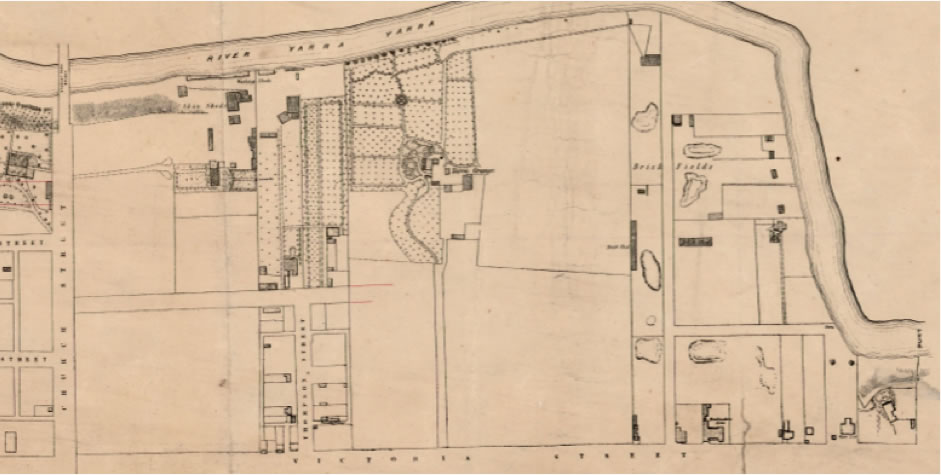
Plan shewing the streets and buildings in existence in East Collingwood on January 1st 1858, compiled from surveys executed under the direction of Clement Hodgkinson.
Note the brick fields, the punt at Walmer Street, the original Brickmaker’s Arms, and Yarra Grange and other large estates to the west.
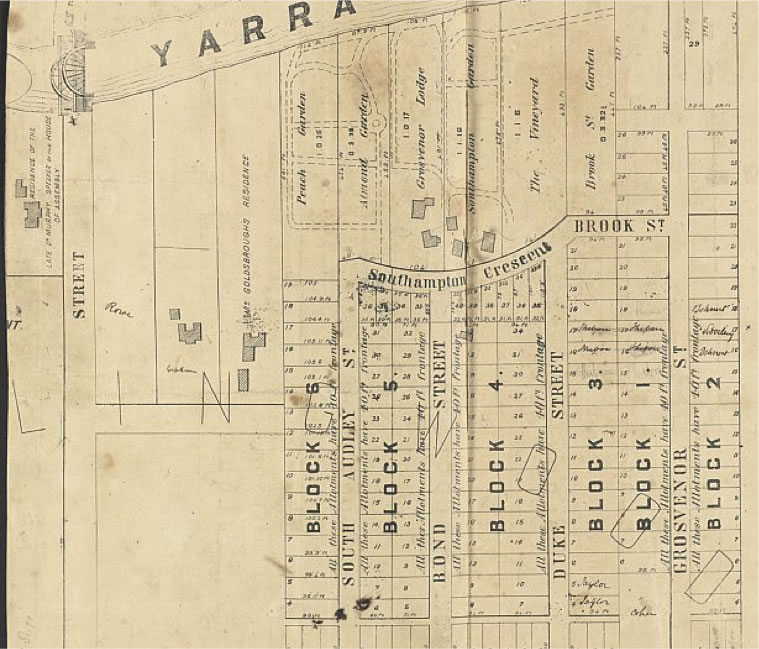
Sale plan (1858 -1862?) shows the remaining mansions in Portion 61 and gradual subdivision. From National Library of Australia
Walk westwards through the car park to Grosvenor Street.
Grosvenor Street was part of the subdivision of the large Grosvenor Estate belonging to Mr Norton’s Grosvenor Lodge (previously and later known as Yarra Grange) which was sold from late 1858 onwards. Some riverside allotments were still quite large, while those in Grosvenor Street were mostly 40 ft by 99 ft (dimensions still existing in remaining properties on the west side). The west side developed as mainly residential, although the width of the plots meant that small businessmen such as cab owners, cabinet makers and a dairyman could ply their trades from home, while from 1870 a pub supplied conviviality after work. On the east side there were only three residences near Victoria Street, and one associated with the tannery towards the river; the rest was industrial. William Melchior was another brickmaker who remained in the area until his death (in 1898); he lived at number 25 and had his brickworks on the opposite side of the street.
3. Site of tannery on east side nr river (now car park) James Bond Hayman, previously in partnership with Robert Flockhart, established the business around 1859 and continued until his death in 1892, after which it was taken over by the McLean Brothers. Hayman was known for the quality of his leather, showing saddlery, harness and dressed shoe leather at exhibitions during the 1880s. He lived in a house next to the Australian Asbestos Company factory, and conducted his tannery between the house and the river. For photos of the old tanning pits which were recently unearthed, go to http://vhd.heritage.vic.gov.au/vhd/heritagevic#detail_places;149540
4. Australian Asbestos Company erected 1888. Henry Walker was one of the directors of the company. The building was taken over by Phoenix Biscuit Company about 1910.
5. Grosvenor St nw cnr Southampton Crescent. Melbourne Ice Co., Victoria Ice Co. Constructed 1889-90. Taken over by the Phoenix Biscuit Co about 1910.
6. Grosvenor St. Phoenix Biscuit Company. Constructed around 1925 on the southwest corner, a single story building with a curved parapet and the company initials in low relief and believed to have been used as their main office. The brickwork has unfortunately been painted over. Phoenix Biscuits, later Weston’s, was associated with Abbotsford for many decades and closed fairly recently.
7. [37] Grosvenor St. Site of Grosvenor Hotel, a two-storey brick building with 12 rooms, which operated from 1870 to 1918.
8. 21 Grosvenor St. Victorian house, later altered. Residence for many years of Henry Zeigenbein, a cab proprietor. The side driveway would have been convenient for this work.
9. 19 Grosvenor St. (HO 14) Double fronted weatherboard house, built prior to 1864. Owned and occupied by Samuel Cane, a cooper. The oldest surviving building in Grosvenor St.
10. 13 Grosvenor St. (HO 13) 1867 double fronted brick house. Originally just two rooms, it has a skillion-roofed rear section. Tuck-pointed brickwork has been overpainted. Bluestone windowsills. Veranda posts and balustrade are not original. Lived in by Edward Muller, a brickmaker, for over 50 years. Second-oldest extant house in the street, a rare surviving example of a modest worker’s cottage in this district.
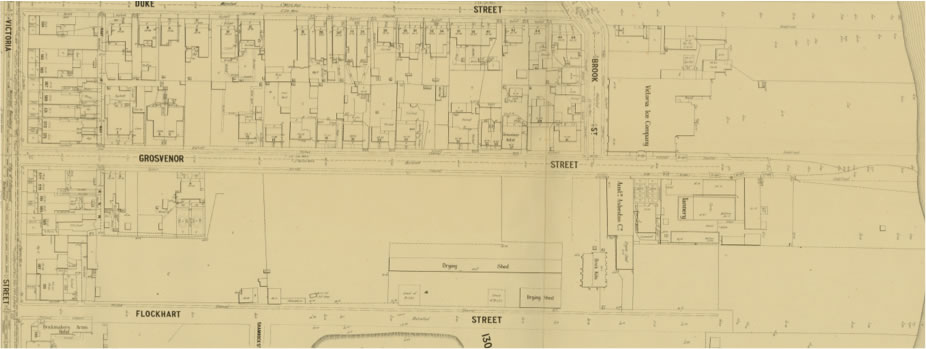
MMBW Detail Plan No. 1305. This 1901 map shows the buildings in Grosvenor Street, the tannery and associated residence, and the remaining brickworks in Flockhart Street.
East side Grosvenor St. A huge building site (Pro-Build / Salvo Property Group) going through to Flockhart Street. The Salvo Property Group bought the site in 2008.(Executive chairman Mario Salvo started as a mechanic then took on a car hire business which he developed into the third largest car hire company in Australia and New Zealand. His son Andrew also works for the privately owned family business). The development will consist of five buildings ranging from five to ten storeys with a total of 450 apartments.
603 Victoria St. Site of the house lived in by Robert Dehnert until his death in 1920. Dehnert owned much of the land in Flockhart Street. He built the Grosvenor Brewery to the west of the house for his son Reinhold to run. Most of his children lived with him or in the Terminus Hotel. In 1954 two old bachelor sons, Alfred and Hermann, were still living in this house. Alfred made the news headlines when he died leaving money to his dog Bob (well, actually when you read the article, he left money for his dog to be cared for). The house was demolished in the 1990s.
11. 605 Victoria St. Terminus Hotel closed in 2012. This building was erected for brickmaker and landowner Robert Dehnert in 1867. Called the Brickmaker’s Arms until 1923, its new name would have been a reference to the cable tram route which terminated just before the river. (The cable tram shed was on the other side of Victoria Street). In the 1930s when the Moderne craze swept through Melbourne, the hotel was remodelled in distinctive style.
Victoria St a few doors to the east. Site of the first Brickmaker’s Arms, conducted from 1853 to 1867. Owned by Joseph Shirley and James Stacey who also ran a brick making business. They employed at least half a dozen brick makers who all lodged in the hotel, but later sold out to Dehnert.
12. Victoria St. site of Green Square, a Salta Property development – you too could be cool – just buy an apartment here. Augustus Fritsch the brickmaker and Henry Walker the candle-maker were located in this area in the nineteenth century. Sam Tarascio senior, a Sicilian migrant, founded Salta 30 years ago and he was later joined by his son Sam junior. The company, which is now one of Australia’s largest privately-owned companies, developed the Victoria Gardens precinct in the 1990s.
Note in Flockhart Street, southeast corner of Shamrock Street, a different type of development: Yarra Community Housing (five levels 54 studio and one bedroom apartments) was completed in 2010 as part of the Federal Government’s social housing initiative in partnership with Salta and City of Yarra.
13. [627] Victoria St. Brewery/Vinegar/Skipping Girl. This is the front of the site we talked about earlier. (See 1.)

MMBW Detail Plan No 1302 dated 1901 shows development east of Walmer St. The large building in extensive grounds immediately east of Walmer Street was the Tivoli (German) Club.
14. 651-653 Victoria St. (HO63) Former Crusader Plate built 1937 as an extension to the neighbouring works to the east and designed in sympathy with it. The use of colour graduated brickwork (dark brown/red/warm cream/light cream) may be unique in Melbourne. The Skipping Girl is now located on the roof of this building. Part of the rear was demolished and new office buildings have been added.
15 . 655 Victoria St. Former Handley and Tilley built 1929. (HO64) The company was involved in the manufacture of aluminium plate. Now “Skipping Girl Apartments”. A lovely building, described as ‘an extraordinarily confident expression of the Moderne idiom’ with a strong vertical central element and symmetrical curves to either side. The whole complex is an excellent example of the Moderne style as applied to industrial architecture, and is of state significance. Cross to the other side of Victoria St for a better overall view.
16 . 659 Victoria St. Yarra Yarra apartments. A recent residential development.
17 . 663 Victoria St. Peter Nettleton’s house built 1861-1862. Note the initials PN in the glass.
Nettleton, a Yorkshireman who had worked in the woollen cloth trade, arrived in Melbourne in 1849 and was employed as a fellmonger until the discovery of gold when he went off to the goldfields where he met with some success. He married Mary Anne in December 1852 and around this time is believed to have bought the land in Portion 63 and returned to fellmongering. His property according to the 1864 rate book included five wooden cottages so he probably lived in one of those before building his bluestone house. Nettleton died at his home in 1901 aged 77. His only living son Arthur drowned in the Yarra some weeks later; Mary Anne stayed in the house until her death in 1903. The house was a restaurant (Nettleton House) for some years after 1980 while the bluestone stables still house a cafe.
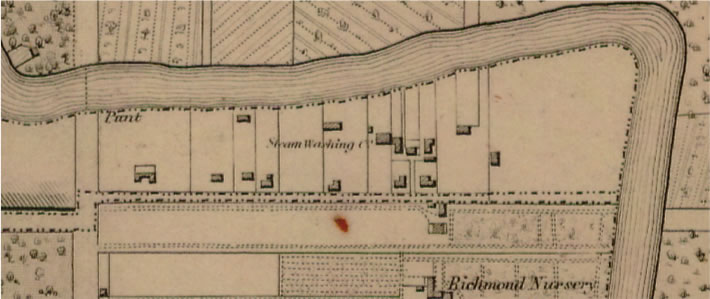
c.1855 map shows a number of buildings in Portion 63. We guess that it was in one of them that Nettleton lived before building his 1861 house and scouring works. Kearney, Melbourne and its suburbs, 1855
Walk down between the buildings towards the river
(Behind Nettleton House.) Former Alma Wool Scouring works, originally Peter Nettleton’s wool scouring works. (HO 65) Woolshed 1 and 2, and part of the wharf, remain. The three-storey woolshed was built around 1861 and is the highlight of this walk. For a detailed contemporary description of the woolwashing process published in The Argus 21 April 1863 , Click Here.
In 1870, Nettleton’s fellmongery was cleaning 3,000 sheepskins per week. A great quantity of animal remains were disposed of in the river creating water and air pollution, with many complaints about the noxious odours .
In 1920 the business was acquired by the Alma Wool Scouring Company, which continued operations until 1980.

MMBW Detail Plan 1302 shows Nettleton’s house, a bricked area for wool drying behind it, two wool sheds, and the wool washing shed by the Yarra.

An early photograph shows woolwashers by the water. Also visible are woolshed number 2, bluestone retaining walls, and Nettleton’s house in the background. Collingwood History Collection PIC 502
18. Yarra Bank Brewery. The precise location has not been identified, but it was near Nettleton’s fellmongery and occupied a site of about half an acre with frontage to the Yarra River for the all-important water source. Constructed in late 1856 and operational by 1857, it was frequently put up for sale or lease. The owner was George Copping, a man better known for his entrepreneurial and theatrical activities. At its inception it was described as ‘capable of making 60 hhds (hogsheads) of ale weekly, or by brewing twice a day, double the quantity… a six-horse engine, which drives the malt-mill and force-pump which discharges… 14,000 gallons of water from the Yarra – enough for one week’s brewing.’ The brewery was operated by Layard and Murray and later by Lister and Lang. In 1864 an advertisement in The Argus indicated that the buildings were being dismantled and the components offered for sale.
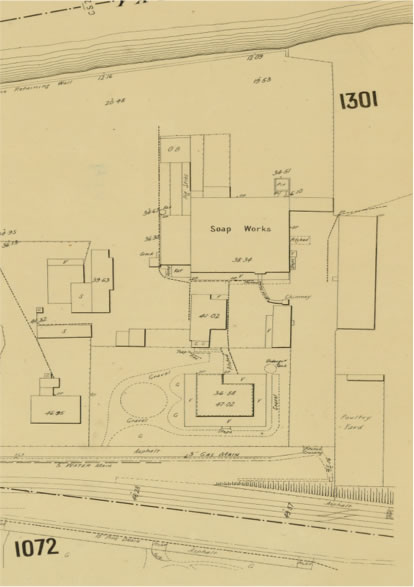
MMBW Detail Plan No. 1302 shows the soap works (note the pig sties). Towards the street frontage is Walker’s house, surrounded by verandas, gravel paths, and garden beds.
19. Haven development site, Former Honeywell site, former site of Henry Walker’s soap factory. A John Boehme had a tallow works on this site prior to Walker taking over in the 1860s. Henry Walker was another Yorkshireman, the proprietor of the Hobson’s Bay Soap and Candle Company, and became a long-serving Collingwood councillor, occupying the mayoral seat in 1873, 1875, 1878-79, 1880-81, and 1887-88. He was also a Justice of the Peace and chairman of the local bench for many years. He held a long lease on this land which was owned by Peter Nettleton. At his death in 1900 the property included a brick house, two old weatherboard cottages, and an area ‘let as a Chinese garden’ (i.e. market garden conducted by Chinese people). There is a portrait of him, painted by Tom Roberts, in Collingwood Town Hall.
The new development on this site is massive, comprising three separate buildings rising up to 11 storeys. In spite of a huge number – 1418 – of objections, Yarra Council approved the proposal. It was then challenged but ultimately accepted by VCAT in October 2010. The Yarra banks have become a battleground between developers wanting high rise structures and residents and other concerned individuals and organisations wanting a peaceful riparian environment and views for all.
20. Victoria St Bridge. A bridge across this section of the Yarra had been discussed for some years, but owing to the need for four councils to agree, and the cost of the project, which would involve acquiring land, it was 1879 before serious plans were underway. Building commenced in 1882, partly on land owned by Peter Nettleton. Henry Walker donated 100 pounds towards the construction (the bridge was going to be good for business for both Walker and Nettleton). The bridge was officially opened in 1884. Unfortunately it soon became known as the suicide bridge, as its height made it ideal for that purpose. Follow the links below for photos of the area.
In an 1884 photograph taken by Charles Nettleton from the Kew side, there is a good view of the buildings on the Richmond/Abbotsford side of the river. To the viewer’s left is the cable tram building, while on the right we can see Henry Walker’s house, the chimney of his soap works, and buildings on Victoria St including refreshment rooms. http://handle.slv.vic.gov.au/10381/69277
A photo of the Victoria Street cable tram in the 1890s gives a close-up view of the refreshment rooms. The chimney of Walker’s soap factory can be seen behind the tram. http://www.hawthorntramdepot.org.au/trams/index.htm
Collingwood Historical Society, Inc, Reg. No. A0030731L.
This is an expanded version of the handout used on the day of the walk.
